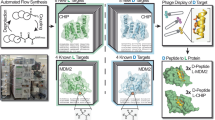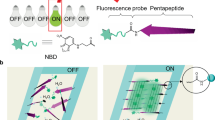Abstract
Miniaturized, spatially addressable microchips of peptides and peptidomimetics are powerful tools for high-throughput biomedical and pharmaceutical research and the advancement of proteomics. Here we report an efficient and flexible method for the parallel synthesis of peptides on individually addressable microchips, using digital photolithography and photogenerated acid in the deprotection step. We demonstrate that we are able to synthesize thousands of peptides in a 1 cm2 area on a microchip using 20 natural amino acids as well as synthetic amino acid analogs, with high stepwise yields and short reaction-cycle times. Epitope screening experiments using a p53 antibody (PAb240) produced clearly defined binding patterns. The peptidomimetic sequences on the microchip show specific antibody binding and provide insights into the molecular details responsible for specificity of epitope binding. Our approach requires just a conventional synthesizer and a computer-controllable optical module, thereby allowing potential development of peptide microchips for various pharmaceutical and proteomic applications in routine research laboratories.
This is a preview of subscription content, access via your institution
Access options
Subscribe to this journal
Receive 12 print issues and online access
$209.00 per year
only $17.42 per issue
Buy this article
- Purchase on Springer Link
- Instant access to full article PDF
Prices may be subject to local taxes which are calculated during checkout




Similar content being viewed by others
References
Merrifield, R.B. Solid phase peptide synthesis. I. The synthesis of a tetrapeptide. J. Am. Chem. Soc. 85, 2149–2154 (1963).
Merrifield, R.B. Solid phase synthesis. Science 232, 341–347 (1986).
Lam, K.S. et al. A new type of synthetic peptide library for identifying ligand-binding activity. Nature 354, 82–84 (1991).
Houghten, R.A. et al. Generation and use of synthetic peptide combinatorial libraries for basic research and drug discovery. Nature 354, 84–86 (1991).
Frank, R. SPOT-synthesis: an easy technique for the positionally addressable, parallel chemical synthesis on a membrane support. Tetrahedron 48, 9217–9232 (1992).
Fodor, S.P.A. et al. Light-directed, spatially addressable parallel chemical synthesis. Science 251, 767–773 (1991).
Lebl, M. Solid-phase synthesis on planar supports. Biopolymers 47, 397–404 (1998).
Beck-Sickinger,A.G. & Jung, G. From multiple peptide synthesis to peptide libraries. in Combinatorial Peptide and Nonpeptide Libraries. A Handbook (ed. Jung, G.) 79–109 (VCH, New York, 1996).
Emili, A.Q. & Cagney, G. Large-scale functional analysis using peptide or protein arrays. Nat. Biotechnol. 18, 393–397 (2000).
Li, M. Applications of display technologies to protein analysis. Nat. Biotechnol. 18, 1251–1256 (2000).
Furka, A. Chemical synthesis of peptide libraries. in Combinatorial Peptide and Nonpeptide Libraries. A Handbook (ed. Jung, G.) 111–138 (VCH, New York, 1996).
Lam, K.S. & Renil, M. From combinatorial chemistry to chemical microarray. Curr. Opin. Chem. Biol. 6, 353–358 (2002).
Winssinger, N., Harris, J.L., Backes, B.J. & Schultz, P.G. From split-pool libraries to spatially addressable microarrays and its application to functional proteomic profiling. Angew. Chem. Int. Ed. 40, 3152–3155 (2001).
Kramer, A. & Scheinder-Mergener, J. Synthesis and screening of peptide libraries on continuous cellulose membrane supports. Methods Mol. Biol. 87, 25–39 (1998).
Wenschuh, H. et al. Coherent membrane supports for parallel microsynthesis and screening of bioactive peptides. Biopolymers 55, 188–206 (2000).
Kramer, A. et al. Spot synthesis: observations and optimizations. J. Pept. Res. 54, 319–327 (1999).
Cho, C.Y. et al. An unnatural biopolymer. Science 261, 1303–1305 (1993).
Stewart, J.M. & Young, J.D., eds. Solid Phase Peptide Synthesis (Pierce Chemical Co., Rockford, IL, 1984).
Beier, M. & Hoheisel, J.D. Production by quantitative photolithographic synthesis of individually quality checked DNA microarrays. Nucl. Acids Res. 28, 11e (2000).
Yu, P. et al. Oligonucleotide synthesis using solution photogenerated acids. J. Am. Chem. Soc. 120, 12698–12699 (1998).
Leproust, E. et al. Combinatorial screening method for synthesis optimization on a digital light-controlled microarray platform. J. Comb. Chem. 2, 349–354 (2000).
Pellois, J.P., Wang, W. & Gao, X. Peptide synthesis based on Boc chemistry and solution photogenerated acids. J. Comb. Chem. 2, 355–360 (2000).
Gao, X. et al. A flexible DNA chip synthesis gated by deprotection using solution photogenerated acids. Nucleic Acids Res. 29, 4744–4750 (2001).
Stephen, C.W. & Lane, D.P. Mutant conformation of p53. Precise epitope mapping using a filamentous phage epitope library. J. Mol. Biol. 225, 577–583 (1992).
Stephen, C.W., Helminen, P. & Lane, D.P. Characterization of epitopes on human p53 using phage displayed peptide libraries: insights into antibody-peptide interactions. J. Mol. Biol. 248, 58–78 (1995).
MacDonald, S.A., Willson, C.G. & Fréchet, J.M. Chemical amplification in high-resolution imaging systems. Acc. Chem. Res. 27, 151–157 (1994).
Willson, C.G. Organic resist materials. in Introduction to Microlithography (eds Thompson, L.F., Willson, C.G. & Bowden, M.J.) 138–267 (Am. Chem. Soc., Washington, DC, 1994).
Singh-Gasson, S. et al. Maskless fabrication of light-directed oligonucleotide microarrays using a digital micromirror array. Nat. Biotechnol. 17, 974–978 (1999).
McGall, G.H. et al. The efficiency of light-directed synthesis of DNA arrays on glass substrates. J. Am. Chem. Soc. 119, 5081–5090 (1997).
Leproust, E., Zhang, H., Yu, P., Zhou, X. & Gao, X. Characterization of oligodeoxyribonucleotide synthesis on glass plates. Nucleic Acids Res. 29, 2171–2180 (2001).
The Chipping Forecast. Nat. Genet. 21 (Suppl), (1999).
Devlin, J.J., Panganiban, L.C. & Devlin, P.E. Random peptide libraries: a source of specific protein binding molecules. Science 249, 404–406 (1990).
Scott, J.K. & Smith, G.P. Searching for peptide ligands with an epitope library. Science 249, 386–390 (1990).
Felici, F., Castagnoli, L., Musacchio, A., Jappelli, R. & Cesareni, G. Selection of antibody ligands from a large library of oligopeptides expressed on a multivalent exposition vector. J. Mol. Biol. 222, 301–310 (1991).
Cwirla, S.E., Peters, E.A., Barrett, R.W. & Dower, W.J. Peptides on phage: a vast library of peptides for identifying ligands. Proc. Natl. Acad. Sci. USA. 87, 6378–6382 (1990).
Pellois, J.P. Photogenerated reagents and light-directed parallel synthesis of peptide microarrays (PhD Thesis) (Univ. of Houston, Houston, TX, 2002).
Bochet, C. Wavelength-selective cleavage of photolabile protecting groups. Tetrahedron Lett. 41, 6341–6346 (2000).
Acknowledgements
This research is supported by grants from the National Institutes of Health, National Cancer Institute, National Science Foundation, Texas ATP, the National Foundation for Cancer Research, and the R.A. Welch Foundation. We thank Ciro Nishiguchi for programming DIGI-SYN, Eric Leproust for sharing results on DNA chip synthesis and discussions, and Texas Instruments for the Digital Light Projector evaluation kits.
Author information
Authors and Affiliations
Corresponding author
Rights and permissions
About this article
Cite this article
Pellois, J., Zhou, X., Srivannavit, O. et al. Individually addressable parallel peptide synthesis on microchips. Nat Biotechnol 20, 922–926 (2002). https://doi.org/10.1038/nbt723
Received:
Accepted:
Published:
Issue Date:
DOI: https://doi.org/10.1038/nbt723
This article is cited by
-
The Trypanosoma cruzi Antigen and Epitope Atlas: antibody specificities in Chagas disease patients across the Americas
Nature Communications (2023)
-
Glycan chip based on structure-switchable DNA linker for on-chip biosynthesis of cancer-associated complex glycans
Nature Communications (2021)
-
Polymer brush hypersurface photolithography
Nature Communications (2020)
-
Surface-functionalization of isotactic polypropylene via dip-coating with a methacrylate-based terpolymer containing perfluoroalkyl groups and poly(ethylene glycol)
Polymer Journal (2019)
-
Novel biotechnological platform based on baculovirus occlusion bodies carrying Babesia bovis small antigenic peptides for the design of a diagnostic enzyme-linked immunosorbent assay (ELISA)
Applied Microbiology and Biotechnology (2018)



